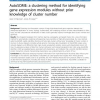Free Online Productivity Tools
i2Speak
i2Symbol
i2OCR
iTex2Img
iWeb2Print
iWeb2Shot
i2Type
iPdf2Split
iPdf2Merge
i2Bopomofo
i2Arabic
i2Style
i2Image
i2PDF
iLatex2Rtf
Sci2ools
BMCBI
2010
2010
AutoSOME: a clustering method for identifying gene expression modules without prior knowledge of cluster number
Background: Clustering the information content of large high-dimensional gene expression datasets has widespread application in "omics" biology. Unfortunately, the underlying structure of these natural datasets is often fuzzy, and the computational identification of data clusters generally requires knowledge about cluster number and geometry. Results: We integrated strategies from machine learning, cartography, and graph theory into a new informatics method for automatically clustering self-organizing map ensembles of high-dimensional data. Our new method, called AutoSOME, readily identifies discrete and fuzzy data clusters without prior knowledge of cluster number or structure in diverse datasets including whole genome microarray data. Visualization of AutoSOME output using network diagrams and differential heat maps reveals unexpected variation among well-characterized cancer cell lines. Co-expression analysis of data from human embryonic and induced pluripotent stem cells...
| Added | 08 Dec 2010 |
| Updated | 08 Dec 2010 |
| Type | Journal |
| Year | 2010 |
| Where | BMCBI |
| Authors | Aaron M. Newman, James B. Cooper |
Comments (0)

